Fujifilm FinePix Real 3D W3 Review
Fujifilm FinePix Real 3D W3
Fuji's unique stereoscopic compact camera captures the world in 3D.
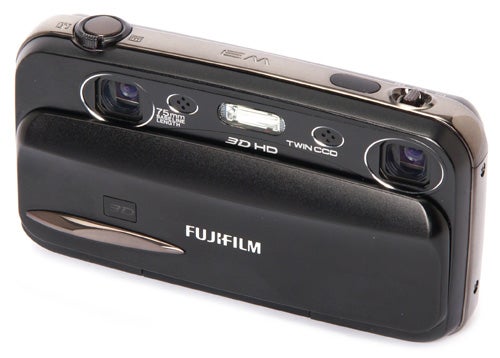
Verdict
Key Specifications
- Review Price: £339.00
Everybody seems to be talking about 3D these days. It’s been around before and never really caught on, so is it just the latest passing fad or is 3D entertainment really here to stay this time? The film companies love it because 3D cinema movies are harder to pirate, and the TV manufacturers like it because it means they can flog us expensive new 3D plasma TVs for our living rooms. Panasonic has launched a 3D camcorder and a 3D lens for its G-Micro compact system camera range, but today I’m taking a look at Fujifilm’s FinePix W3, a stereoscopic 3D compact camera that can not only shoot 3D still images and 3D HD video, it can even display them thanks to a unique 3D monitor that doesn’t require the wearing of special glasses.
The W3 isn’t Fujifilm’s first 3D still camera; it launched the similar FinePix W1 last summer to a rather lukewarm reception, but apparently it sold well enough to justfy a sequel, so the new W3 adds 3D HD video recording with stereo audio to the formula, along with improvements to the 3D monitor. It still has the same basic configuration as the W1, with a sliding front panel concealing a pair of internal 3x zoom lenses, twin microphones and the built-in flash.
Unlike the Panasonic system which uses split images on a single sensor with relatively little parallax separation, the W3 is essentially two complete 10 megapixel, 3x zoom cameras in the same case, with a separation of approximately 7.5cm (3in) between the lenses, about the same as the distance between human eyes. Because of this it’s a physically large and heavy camera compared to most compacts, measuring 124 x 65.9 x 27.8mm and weighing approximately 250g including battery and memory card.
Pictures and video shot on the W3 can be viewed in 3D on the camera’s own monitor screen, on any suitable 3D TV, on an optional 3D digital picture frame (the Real 3D V1) that uses the same display technology as the camera’s monitor, or by having the pictures printed by Fujifilm’s special 3D printing service, which is available via Fujifilm’s website.
The 3D printing technology is ingenious. No special glasses are needed since it uses a very fine-textured Fresnel lens surface on a thin plastic sheet to produce an autostereoscopic image. The 3D effect is surprisingly good, but not all subjects are suitable for printing. Only horizontal (landscape format) images will work in 3D, and the process also doesn’t handle very fine detail, low light or extremes of distance particularly well. The prints are also expensive; 6×4 inch snapshot-sized prints are £3.99 each, with a £4.99 delivery charge. A home 3D printer has been developed and was shown at this year’s Focus On Imaging camera show, but it is not available to the public, or at least not yet.
The camera’s 3D monitor uses the same autostereoscopic Fresnel micro-lens technique as the printing system, and again the three-dimensional effect is surprisingly convincing, although it only really works when the screen is viewed straight on. Viewing the image is a bit like looking at one of those “magic eye” pictures. You have to slightly de-focus your eyes and look into the image to get the full effect, but the sense of depth is very compelling.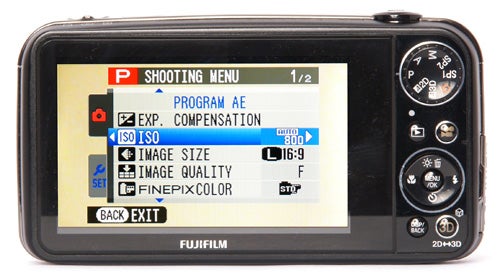
The only problem with it, and this is something that is true of 3D movies like ”Avatar” as well, is that the focus point and depth of field is fixed when the photo is taken, and this confuses the eye somewhat. You expect objects in the foreground and background to come into focus when you look at them, or to go out of focus when you look at something closer or further away, but they don’t. This breaks the 3D illusion to a certain extent, and means that objects tend to look a bit like flat cardboard cut-outs. Nonetheless it is a remarkable feat of technology and a guaranteed conversation-starter when you show people the results on the monitor. The screen is at least large (3.5 inches), bright and exceptionally sharp, with a resolution of 1.15 million dots.
Due to the camera’s unusual design it does have one minor handling issue. It you hold the camera in one hand like any normal compact, making use of the finger-grip detail on the front panel, it is very easy to accidentally get your finger in front of the right-hand lens. It’s better to hold the camera in both hands and keep your fingers well out of the way when shooting. Despite this the camera is well made and looks quite sleek despite its bulk.
In terms of actual photographic ability the W3 is the equivalent of a fairly average mid-range compact. It has optional aperture priority or full manual exposure, although the range of available settings is rather limited, with only three aperture settings and shutter speeds from ½ to 1/500th of a second. There are several automatic exposure modes to choose from, including program auto and “easy” full auto, two scene mode settings each with a choice of 14 scene programs, and two modes that are unique to this camera. One is the option to take two 2D photos simultaneously with different settings, while the other can enhance the 3D effect by taking two consecutive photos, but with the user moving the camera between shots to provide a wider parallax. The camera’s processor then merges the two shots to produce a 3D image.
Other features are fairly standard. The lens focal length is equivalent to 35 – 105mm, about average for a 3x zoom camera. The ISO range is 100 to 1600, and for colour tone it has Fuji’s usual film modes, with standard, a high-saturation Chrome, and monochrome black and white available. It has spot, centre-weighted and multi-zone metering, selectable 2D focus mode and adjustable white balance. Not too surprisingly it only has digital image stabilisation.
Apart from the fact that it can shoot in 3D the video mode is fairly unremarkable. It shoots at a maximum resolution of 1280 x 720 at 30fps, and optical zoom cannot be used while recording. The video quality isn’t particularly brilliant when viewed on the monitor, and the sound playback through the camera’s speaker is quite tinny. I’m sadly not rich enough to own a 3D TV, and neither is anyone that I know, so I wasn’t able to view the 3D movies anywhere else. Super-fast Class 10 SD cards are recommended for recording HD 3D video.
The W3’s overall performance is a bit slow when compared to a conventional compact camera, but when you actually consider the processing that’s taking place it really is remarkably quick. It takes approximately eight seconds to start up and shoot a picture, which is very slow, but in single shot 3D mode its shot-to-shot time is approximately 3.5 seconds. I’ve seen some conventional cameras that shoot slower than that. It has a continuous shooting mode which shoots four frames in about 2.5 seconds, but then slows down to a shot every two seconds.
The autofocus system is quick and accurate in good light, and works well even in quite dim lighting, but there is no AF assist lamp so once it gets darker than, say, a candle-lit room it won’t focus, and since the 3D effect also relies on the AF system that doesn’t work in very dim light either.
The relatively small 1000mAh battery is effectively powering two cameras as well as the high-res 3D monitor, but during testing it still managed well over 200 shots and several video clips on a full charge, which is quite an impressive performance.
The image quality is hard to quantify. 3D images are stored not at a stereo pair of JPEG images, but as a JPEG image and a larger MPO file which contains the 3D data. Shooting in 2D mode the camera only uses the left-hand lens and sensor, and the still image quality is reasonably good, although not a patch on what you’d expect from a conventional £300 compact Although the images have relatively low compression they lack fine detail and even in the standard film mode the colours are a bit blotchy with an over-processed look. The lens quality also leaves something to be desired, with quite a bit of wide-angle barrel distortion and chromatic aberration.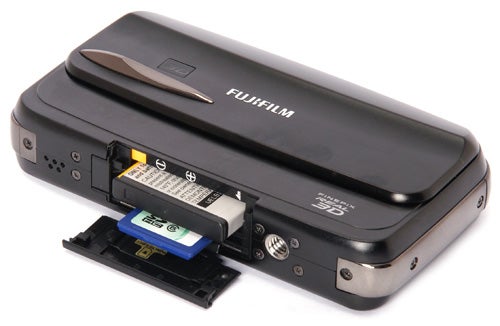
Fujifilm cameras have long had an excellent reputation for high-ISO performance and here the W3 is on safe ground. Images at up to 800 ISO have very low noise and plenty of detail, and even at the 1600 ISO maximum the image quality is surprisingly good. Nonetheless the overall image quality is nowhere near as good as the FinePix F70 EXR, which costs less than half as much, so you’ll have to decide if the ability to shoot in 3D is worth the money.
”’Verdict”’
The FinePix Real 3D W3 is, to say the least, an interesting camera. There’s no doubt that as a 3D still and video camera it works superbly, but unless you have a 3D TV to view the pictures, or can afford the remarkable but expensive 3D prints, it is really more of a clever gimmick than a useful camera. The 2D picture quality isn’t as good as a conventional compact costing half as much.

”Over the next few pages we show a range of test shots. On this page the full size image at the minimum and maximum ISO settings have been reduced to let you see the full image, and a series of full resolution crops have taken from original images at a range of ISO settings to show the overall image quality. These pictures were taken indoors using tungsten photoflood. ”
—-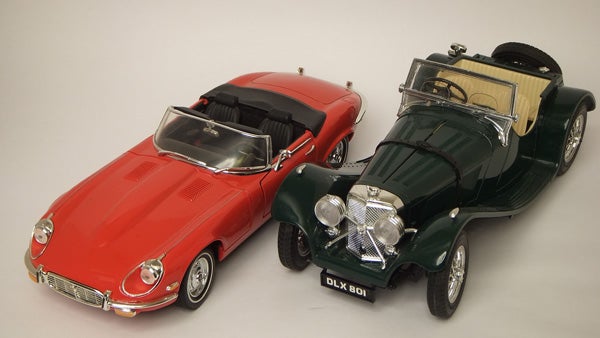
This is the full frame at minimum ISO.
—-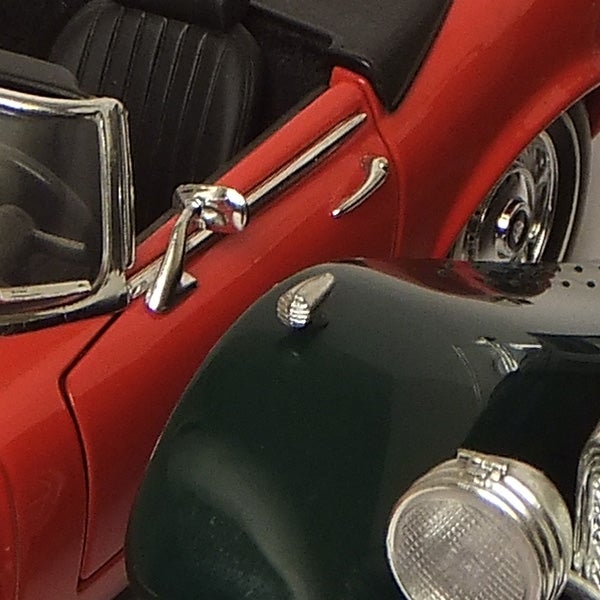
At 100 ISO the image quality is very good, with no noise.
—-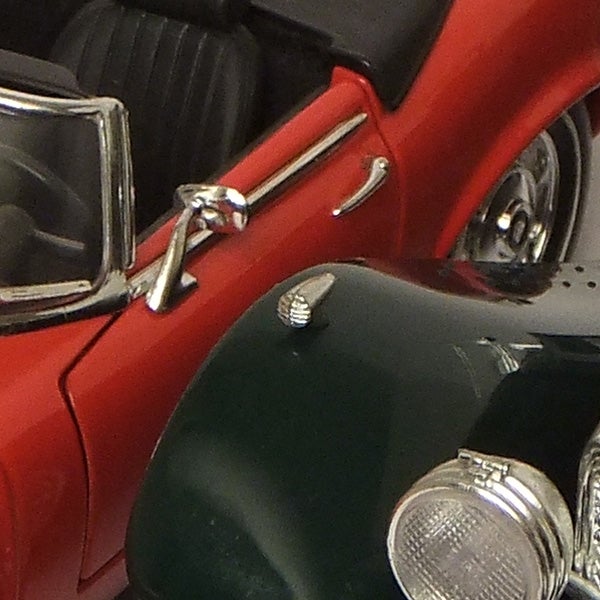
Still no noise at 200 ISO.
—-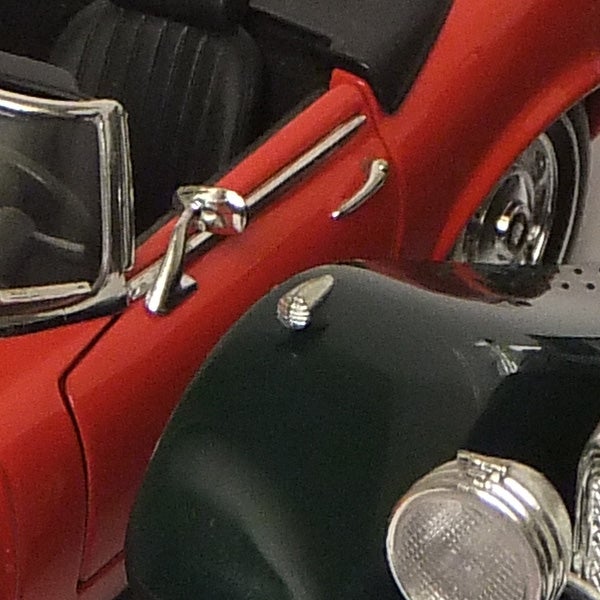
There is slightly more processing going on at 400 ISO, but the image quality is still good.
—-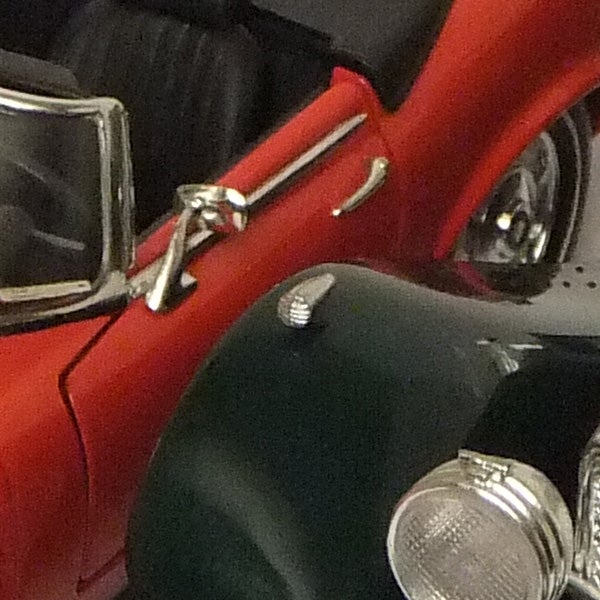
There is slight loss of detail at 800 ISO, but the overall quality is still good.
—-
D photo of a red toy car taken with Fujifilm FinePix Real W3.” width=”300″ height=”300″ class=”align size-medium wp-image-210832″ srcset=”https://www.trustedreviews.com/wp-content/uploads/sites/54/2010/11/14402-w3iso1600-1.jpg 600w, https://www.trustedreviews.com/wp-content/uploads/sites/54/2010/11/14402-w3iso1600-1-150×150.jpg 150w, https://www.trustedreviews.com/wp-content/uploads/sites/54/2010/11/14402-w3iso1600-1-300×300.jpg 300w, https://www.trustedreviews.com/wp-content/uploads/sites/54/2010/11/14402-w3iso1600-1-320×320.jpg 320w, https://www.trustedreviews.com/wp-content/uploads/sites/54/2010/11/14402-w3iso1600-1-500×500.jpg 500w” sizes=”(max-width: 300px) 100vw, 300px” />
Even at 1600 ISO the quality is far from terrible.
—-
This is the full frame at maximum ISO.
”A range of general test shots are shown over the next two pages. In some cases, the full size image has been reduced for bandwidth purposes, and a crop taken from the original full resolution image has been placed below it to show the overall image quality. Some other pictures may be clicked to view the original full-size image. ”
—-
I couldn’t get to my usual spot in front of the Cathedral due to building work, so here’s an alternative. I’ll try and get to the Cathedral later in the week if possible. File size 3.3MB.
—-
The level of detail isn’t particularly good even for a 10MP camera.
—-
The lens does produce some barrel distortion at wide angle, but it’s not too severe.
—-
”Here are some general test shots to help evaluate the camera’s overall image quality, including dynamic range, colour rendition and the zoom range of the lens. Some pictures may be clicked to download the full size original image. ”
—-
The wide angle is equivalent to 35mm.
—-
The telephot end is equivalent to 105mm.
—-
Colour rendition is a alittle blotchy.
—-
The 10MP sensot has reasonable dynamic range, even in this high-contrast shot.
—-
Trusted Score
Score in detail
-
Value 5
-
Image Quality 7
-
Build Quality 8
Features
| Camera type | Digital Compact |
| Megapixels (Megapixel) | 10 Megapixel |
| Optical Zoom (Times) | 3x |
| Image Sensor | 1/2.3-inch CCD x2 |
| Optical focal length | 6.3-18.9mm in 35mm film terms |
| Shutter speed | 3 secs to 1/500 |
| Auto focus | TTL contrast detection |
| Manual focus | N/A |
| Max output resolution | 3648x2736 |
| Other resolutions | 3648x2432, 3584x2016, 2592x1944, 2592x1944, 2592x1728, 2560x1440, 2048x1536, 2016x1344, 1920x1080 |
| Focus range | 60cm- infinity, Macro 38cm |
| Exposure control | Program auto, Aperture Priority, Manual, Auto |
| Exposure metering | Spot, Centre, Multi-zone |
| Exposure compensation | +/- 2EV |
| Image Stabilisation | Digital |
| ISO settings | 100-1600, Auto |
| LCD Monitor | 3.5-inch, 1.15 million dots, 3D autostereoscopic |
| Viewfinder | N/A |
| Flash range | Wide: 3.6m, Tele: 3.1m |
| Flash modes | On, Off, Red-eye reduction |
| White balance modes | Fine, Shade, Fluorescent 1/2/3, Tungsten, Underwater |
| Drive modes | Single, continuous |
| Image formats | JPEG, MPO+JPEG, 3D-AVI, Motion JPG |
| Picture adjustments | Standard, Chrome, Black and White |
| Video (max res/format) | 1280x720, 30fps, stereo audio, no zoom |
| Movie length | Card capacity |
| Self timer | 10/2 secs |
| Memory card slot | SD/SDHC |
| Supplied memory | 34MB internal memory |
| Batteries supplied | 100mAh lithium ion |
| Charger supplied | Yes |
| A/V output | HDMI, |
| Charging/Computer Connection | USB 2.0 |
| HDMI | Yes |
| Manual | Basic printed guide, full manual on CD |
Physical Specifications
| Dimensions Width (Millimeter) | 124mm |
| Depth (Millimeter) | 65.9mm |
| Weight (body only) (Kilogram) | 230g (250g including battery and memory card)kg |

